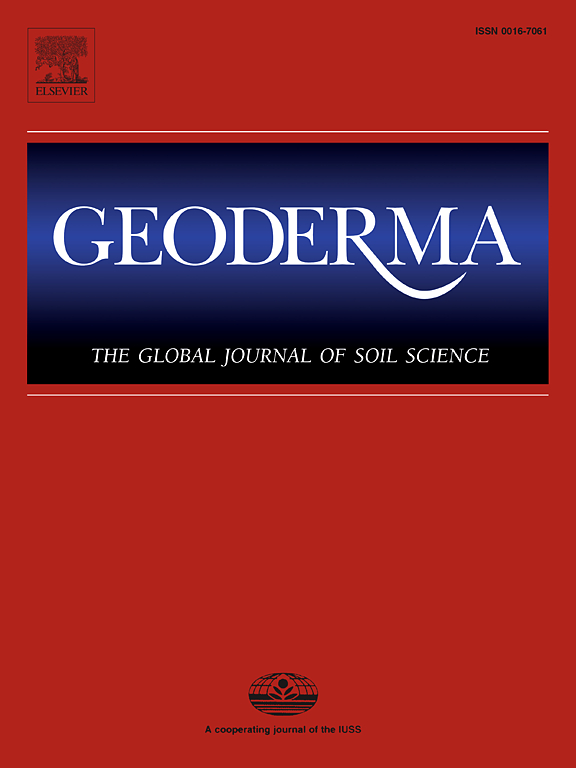Mapping potential water repellency of Danish topsoil
IF 5.6
1区 农林科学
Q1 SOIL SCIENCE
引用次数: 0
Abstract
Soil water repellency (SWR) is a natural process and affects water dynamics from nano to ecosystem scales. However, the spatial distribution of SWR at the ecosystem scale, as well as the underlying drivers across diverse habitats, land uses and soil textures, remain underexplored. This study presents a comprehensive survey of SWR in Denmark and its predicted spatial distribution, using approximately 7,500 samples. We used digital soil mapping methods (Quantile Random Forest model) to map and identify the relationship between SWR and various environmental variables, including vegetation (via satellite imagery), soil properties (texture and soil organic carbon), and landforms (slope and wetness index). The predicted maps at 10 m resolution revealed that SWR varies across different land uses and vegetation types, with higher values in areas of natural vegetation (e.g., heathlands and coniferous forests) compared to grasslands and croplands (mostly hydrophilic). The analysis also identified soil organic carbon, Sentinel band 3 (Green band − Chlorophyll absorption) and soil texture as key drivers of spatial variation in SWR at the national extent. We found that soil texture influences SWR intensity, which generally decreases as clay content increases across most land use types, except for heathlands. While the predicted maps provided valuable insights into SWR distribution and its environmental drivers, further research is needed to explore the spatio-temporal dynamics of SWR within each habitat, particularly in relation to soil moisture changes. This study highlights the potential of combining machine learning and remote sensing to provide crucial spatial information for managing water resources and enhancing ecosystem resilience in the face of climate change.
绘制丹麦表土的潜在防水性
土壤斥水性(SWR)是一个自然过程,影响着从纳米到生态系统尺度的水动力学。然而,在生态系统尺度上,SWR 的空间分布以及不同栖息地、土地利用和土壤质地的潜在驱动因素仍未得到充分探索。本研究利用约 7500 个样本对丹麦的 SWR 及其预测空间分布进行了全面调查。我们使用数字土壤制图方法(定量随机森林模型)绘制并确定了 SWR 与各种环境变量之间的关系,包括植被(通过卫星图像)、土壤特性(质地和土壤有机碳)和地貌(坡度和湿度指数)。10 米分辨率的预测图显示,不同土地用途和植被类型的 SWR 各不相同,与草地和耕地(大多亲水性)相比,自然植被地区(如荒地和针叶林)的 SWR 值更高。分析还发现,土壤有机碳、哨兵波段 3(绿色波段--叶绿素吸收)和土壤质地是全国范围内 SWR 空间变化的主要驱动因素。我们发现,土壤质地影响着 SWR 强度,在大多数土地利用类型中,随着粘土含量的增加,SWR 强度通常会降低,但荒地除外。虽然预测地图为了解 SWR 分布及其环境驱动因素提供了宝贵的信息,但仍需进一步研究,以探索 SWR 在每种生境中的时空动态,尤其是与土壤水分变化的关系。这项研究凸显了机器学习与遥感相结合的潜力,可为管理水资源和提高生态系统在气候变化面前的恢复能力提供重要的空间信息。
本文章由计算机程序翻译,如有差异,请以英文原文为准。
求助全文
约1分钟内获得全文
求助全文
来源期刊

Geoderma
农林科学-土壤科学
CiteScore
11.80
自引率
6.60%
发文量
597
审稿时长
58 days
期刊介绍:
Geoderma - the global journal of soil science - welcomes authors, readers and soil research from all parts of the world, encourages worldwide soil studies, and embraces all aspects of soil science and its associated pedagogy. The journal particularly welcomes interdisciplinary work focusing on dynamic soil processes and functions across space and time.
 求助内容:
求助内容: 应助结果提醒方式:
应助结果提醒方式:


